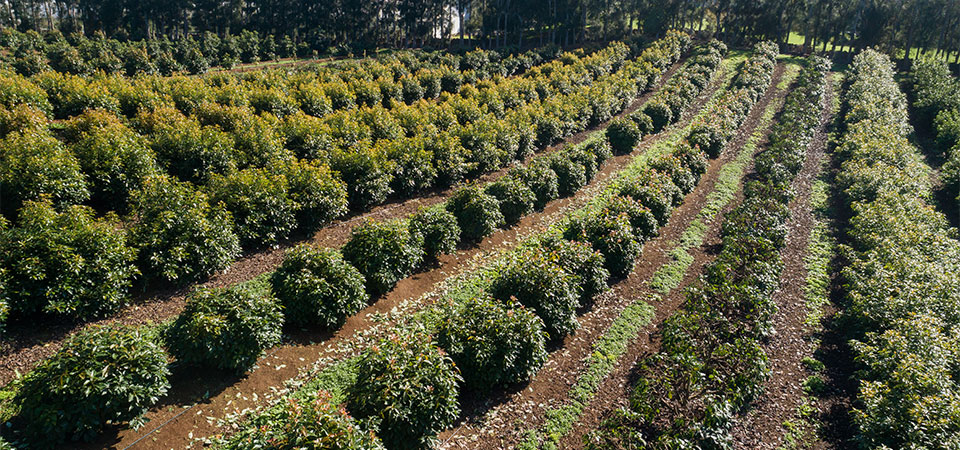Traditional spacing are 7 m x 7 m equating to 200 trees per hectare. High density plantings range from 6 m x 4 m (416 trees per hectare) through to 5 m x 3 m (666 trees per hectare). There are even some experimental spacings as high as 2.5 m x 2.5 m (1600 trees per hectare).
There are numerous advantages to high density planting:
- Reach full production earlier Full production occurs when a full canopy is achieved. Production will start in year three and full productivity will happen in year five or six.
- Trees well sheltered Small trees are easily sheltered. It is impossible to shelter 8-metre-high trees under conventional spacing. Good shelter results in better quality fruit and more fruit as micro climates are created.
- Self-mulching Small trees will self-mulch earlier. This allows roots to grow into the mulch layer which results in improved tree health and more efficient nutrient uptake.
- Improved tree health Regular pruning improves tree health, as root to shoot ratio is kept in balance.
- Better fruit size Improved fruit size as the trees are healthier with a strong efficient canopy and root system.
- Land utilisation Steeper land can be planted as machinery access not as necessary.
- Reduced harvest costs Much reduced harvest costs, as all picking is done from the ground.
- Minimise Health & Safety risks This has Health and Safety advantages and less reliance on skilled cherry picker workers.
- Reduced soil compaction Reduced soil compaction as no cherry pickers and smaller sprayers.
- Less pest and disease damage Better spray penetration, so there will be less insect damage and more effective fungicide application.
- Less fruit staining Less fruit staining as trees maintain a strong vigorous canopy.
Different densities need to be tailored to the site and grower input. We are happy to advise on what will work best for you.
Planting trees intensively means that the fruit numbers required per tree to achieve good yields per hectare are lower. The table below summarises how many fruit per tree are required to achieve different yields at different tree spacings.
| Tonnes/ha | 8 | 10 | 12 | 18 | 22 | 30 | 40 | |
|---|---|---|---|---|---|---|---|---|
| Tree spacing | Trees/ha | Fruit numbers/tree (230g - 24 count) | ||||||
| 7 x 7 | 204 | 171 | 213 | 256 | 384 | 469 | 639 | 853 |
| 5 X 3 | 667 | 52 | 65 | 78 | 117 | 143 | 196 | 261 |
| 3.5 X 3.5 | 816 | 43 | 53 | 64 | 96 | 117 | 160 | 213 |
| 5 x 2 | 1000 | 35 | 43 | 52 | 78 | 96 | 130 | 174 |
| 2.5 x 2.5 | 1600 | 22 | 27 | 33 | 49 | 60 | 82 | 109 |
| 1.25 x 1.25 | 6400 | 5 | 7 | 8 | 12 | 15 | 20 | 27 |
Selecting rootstocks and planting densities
Selecting rootstocks and planting densities are two major considerations when establishing a new orchard block. Every planting site is different, and consideration needs to be given to the soil type and climate when choosing the best rootstock for your site. Planting densities can also vary greatly and there are no “standard” planting densities. How many trees to plant per hectare will depend on the topography of your block, the size of your orchard equipment, and how much labor you have available.
New Zealand Avocado has been carrying out trials over the last 10 years on commercial orchards looking at rootstocks and their performance in different regions and soil types. This work has shown that rootstocks perform differently in different regions and even within regions. Summaries of this information can be found on the NZ Avocado

